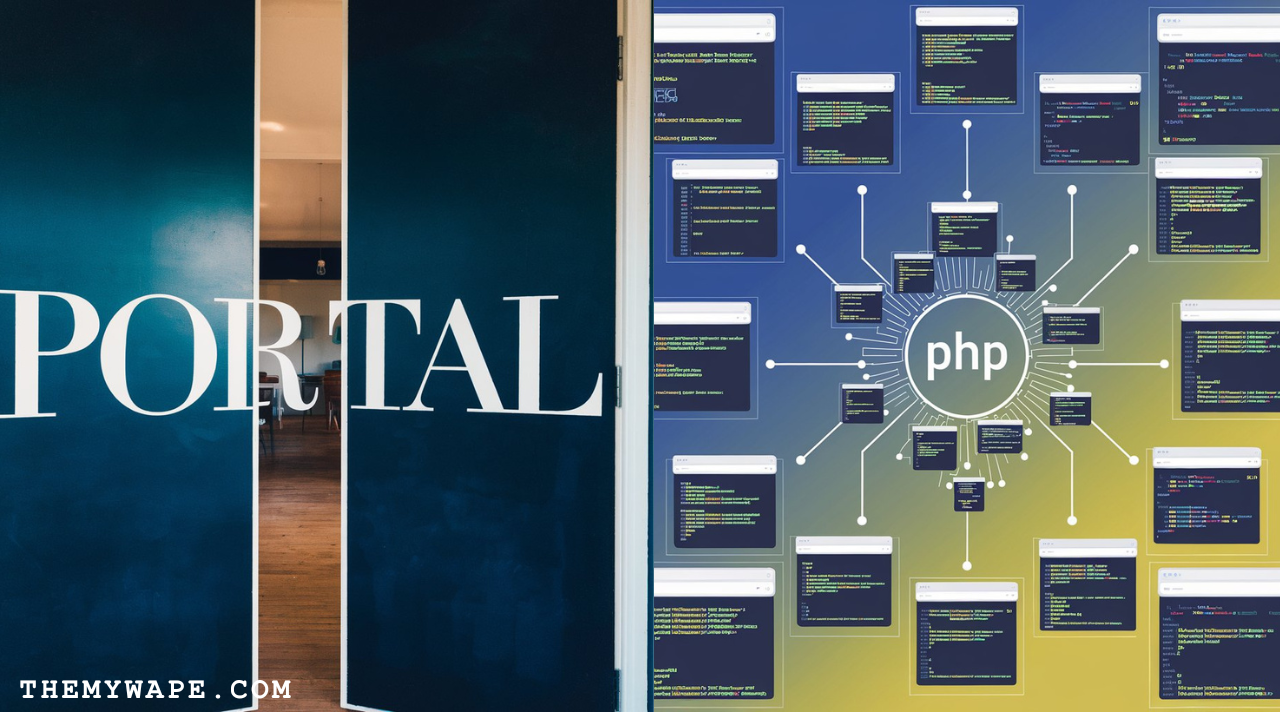Introduction
Portal PHP is a popular topic for developers and businesses looking to create dynamic and interactive web portals. With PHP being one of the most widely used programming languages, building portals with it has become a common choice. The versatility of PHP allows developers to design, manage, and maintain web portals that serve various industries—whether it’s an educational portal, e-commerce platform, or corporate intranet. This article delves into the concept of Portal PHP, its benefits, how to develop one, and best practices for success. By the end of this guide, you’ll have a solid understanding of Portal PHP and how to leverage it for your projects.
Table of Contents
What is Portal PHP?
Portal PHP refers to the use of PHP (hypertext processor) for building web-based portals. A web portal is a centralized online platform that provides access to various resources, information, and services. These portals can serve a specific user base, such as employees, customers, or students, and allow them to access data, communication tools, and applications through a single interface.
PHP, being a server-side scripting language, is particularly well-suited for creating dynamic web portals. Portal PHP enables real-time interaction, user authentication, content management, and seamless integration with databases. The open-source nature of PHP makes it a cost-effective solution for building web portals, making it a preferred choice for many developers.
Key Features of Portal PHP
When developing a portal in PHP, there are several key features you should consider incorporating to make your portal functional and user-friendly. These features are essential for the overall performance, usability, and scalability of your portal.
Content Management System (CMS)
A CMS is another vital feature in Portal PHP. It allows administrators to manage and organize content without needing deep technical expertise. Using PHP, you can create an efficient CMS to control articles, documents, media, and other resources that users interact with.
Database Integration
A successful Portal PHP is heavily reliant on database integration. PHP works seamlessly with databases like MySQL and PostgreSQL to store and retrieve data, making it an excellent choice for building portals where data plays a crucial role.
Responsive Design
Ensuring your Portal PHP is mobile-friendly and responsive, which is essential for reaching a wider audience. PHP frameworks, such as Laravel and CodeIgniter, allow developers to create portals that function well across different devices, ensuring a smooth user experience.
Search Functionality
An efficient search system is an integral part of any Portal PHP. Users need to quickly locate the information they are seeking. With PHP, you can implement advanced search functions that filter and sort through large amounts of data efficiently.
Multilingual Support
For portals serving a global audience, multilingual support is a crucial feature. PHP provides tools and libraries to create portals that offer content in multiple languages, ensuring inclusivity and user accessibility.
Benefits of Using Portal PHP
Building a portal with PHP offers a range of benefits, making it an excellent option for developers and businesses alike. Here’s why Portal PHP is so advantageous:
Cost-Effective
PHP is a free and open-source programming language, meaning no licensing fees are required. This makes Portal PHP development highly cost-effective, especially for small businesses or startups with limited budgets.
Flexibility and Customization
One of the key benefits of Portal PHP is the flexibility it provides. PHP can be customized to meet the specific needs of any project, regardless of its complexity. Whether you’re building a simple internal communication portal or a large-scale e-commerce platform, PHP can handle it all.
Large Developer Community
With a vast community of developers working with PHP, finding support, tutorials, or solutions for challenges in your Portal PHP project is relatively easy. The extensive resources available for PHP ensure that you won’t be left in the dark during development.
Security
Security is a major concern for any web portal, especially those handling sensitive user data. Portal PHP can be designed with various security features, including encryption, secure login systems, and anti-hacking measures, ensuring that your portal remains safe from potential threats.
Scalability
As your business grows, your web portal must scale to accommodate more users and increased functionality. Portal PHP is highly scalable, allowing you to add new features, integrate third-party services, and expand your portal’s capabilities without having to overhaul the entire system.
How to Build a Portal PHP: Step-by-Step Guide
Building a Portal PHP requires careful planning, a clear understanding of user needs, and attention to technical details. Here’s a step-by-step guide to help you create a functional and dynamic portal using PHP:
Define the Portal’s Purpose and Audience
Before you start coding, it’s essential to clearly define the purpose of your portal. Who will be using it? What features do they need? Whether it’s an educational portal, a client communication tool, or an internal corporate platform, understanding the target audience will guide the development process.
Choose a PHP Framework
While PHP can be written from scratch, using a framework will save time and reduce errors. Some popular PHP frameworks for developing Portal PHP include Laravel, CodeIgniter, and Symfony. These frameworks provide pre-built libraries, tools, and components that make portal development faster and more efficient.
Set Up the Development Environment
Ensure that you have a proper development environment set up before starting. This involves setting up a web server (like Apache), PHP, and a database management system (such as MySQL). Tools like XAMPP or WAMP can help streamline this setup process.
Design the User Interface
A clean, user-friendly interface is vital for the success of your Portal PHP. Work with web designers or use templates to create an interface that is both visually appealing and functional. Keep in mind that a responsive design is crucial for users accessing your portal from various devices.
Implement Core Features
Next, start developing the core features of your Portal PHP. This includes user authentication, database integration, and content management. If you’re using a framework, many of these features will have pre-built functions that can be customized according to your needs.
Add Advanced Functionality
Once the core features are in place, you can add advanced functionality to enhance the portal’s user experience. This could include search systems, multilingual support, real-time notifications, or third-party integrations such as payment gateways or APIs.
Launch and Maintain
After testing, your Portal PHP is ready to be launched. However, the work doesn’t stop there. Regular maintenance, updates, and security patches are necessary to keep the portal running smoothly. Monitor user feedback and make improvements over time.
Best Practices for Portal PHP Development
When developing a Portal PHP, following best practices can improve the overall quality and security of the portal:
Use Secure Coding Practices
Always prioritize security when coding. Implement data validation, escape user input, and use prepared statements to prevent SQL injection attacks. Regularly update PHP versions to keep the portal secure.
Optimize for Performance
A slow portal can frustrate users and lead to high bounce rates. Use caching mechanisms, optimize database queries, and minimize the use of external resources to ensure your Portal PHP runs efficiently.
Mobile-First Design
With a growing number of users accessing portals from mobile devices, adopting a mobile-first design approach ensures that your Portal PHP is responsive and functional across all devices.
Regular Backups
Implement a regular backup schedule to ensure that your portal’s data is safe. In case of any system failures or cyberattacks, backups can help you quickly restore your Portal PHP.
FAQs about Portal PHP
What is Portal PHP?
Portal PHP refers to the use of the PHP programming language to develop web-based portals that provide users with access to various resources, services, and tools.
Why should I use PHP to build a web portal?
PHP is cost-effective, flexible, and scalable. It allows for easy database integration, secure user authentication, and the creation of dynamic content, making it an ideal choice for building web portals.
Which PHP frameworks are best for developing a web portal?
Some widely used PHP frameworks for portal development are Laravel, CodeIgniter, and Symfony. These frameworks offer pre-built tools and libraries that simplify the development process.
Can PHP portals handle large amounts of data?
Yes, Portal PHP can efficiently handle large amounts of data when integrated with robust databases such as MySQL or PostgreSQL. Proper optimization techniques can further improve performance.
Is it necessary to have a CMS in a Portal PHP?
A CMS is not mandatory but is highly recommended for portals that require frequent content updates. It allows administrators to manage and organize content easily without needing technical expertise.
Conclusion
Portal PHP is a powerful tool for building interactive, dynamic, and functional web portals. With PHP’s flexibility, scalability, and extensive support from the developer community, creating a portal that caters to your users’ needs is highly achievable. Whether you’re building a portal for internal company use or for your customers, following the steps and best practices outlined in this guide will ensure that your Portal PHP is both user-friendly and efficient. By implementing the right features and maintaining regular updates, your portal can serve as a vital resource for your organization or business.
You can see the latest updates on : MyWape


